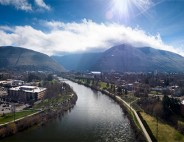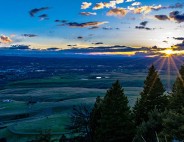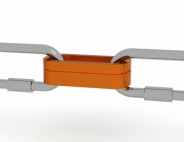Montana’s Sound Finances Mean Predictable Business Costs
28 Nov, 2012
By Sharon H. Fitzgerald
Montana Gov. Brian Schweitzer says his state is a great place to do business because Montana does its own business so well. Schweitzer wraps up his second and final four-year term in January with the state’s fiscal house in order.
“I’ve run eight consecutive years with the largest surpluses in the history of the state every single year, including right through The Great Recession,” Schweitzer says. “And we’ve also been able to cut taxes.” The philosophy harkens back to Montana’s successful homesteaders of a century ago. “The ones who made it were the ones who kept grain in the bin. … That’s the philosophy I’ve used in running the state of Montana,” says Schweitzer, whose four grandparents were successful Montana homesteaders themselves. During the years when states were “awash in cash” — 2005, 2006 and 2007 — Montana put money in the bank, he explains.
As a result, the U.S. Chamber of Commerce and the Tax Foundation ranked Montana No. 8 this year for its business tax climate. “It’s a great place to do business, we’ve got money in the bank and your taxes aren’t going to go up in Montana,” Schweitzer says. “They’re low, and they’re going to stay there.”
Industries and Innovations
Schweitzer and wife, Nancy, are both scientists — an agronomist and a botanist, respectively. Thus, it’s no surprise that the administration has worked to build industry sectors that stress science, technology, engineering and math (STEM). “What I do know is that the economy with the most and best engineers always wins,” Schweitzer says. “The second thing I know is that politicians always talk about changing the world, but politicians don’t change the world. Innovations and ideas change the world.”
While Montana’s economy is largely based on energy, natural resources and agriculture, the state is building a robust technology industry that today directly employs more than 5,000 people. High-tech firms employ 18 of every 1,000 workers in in the state.
“We’ve attracted biotech in a big way to come to Montana,” Schweitzer says, “and we’re also attracting the Internet inventors. They can do their business anywhere. If they have broadband, they can do business in the Silicon Valley or they can do business in Missoula.”
In fact, Kalispell is building its economy on that notion. “We have high-tech manufacturers, many of them, who could have located anywhere in the United States,” says DeAnn Thomas, economic development director of the Kalispell Chamber of Commerce. “More and more, I really believe that quality of life is becoming a major factor in making decisions about where people are looking to establish companies.”
Headquartered in Kalispell is Nomad Global Communication Technologies, founded by four young entrepreneurs who met working as rafting guides one Montana summer. That’s when they came up with the idea to develop mobile vehicles equipped with advanced telecommunications equipment. Today, their vehicles and telecommunications products are in high demand by the U.S. military, federal and state agencies, and the private sector. Another high-tech success story in Kalispell is Semitool, purchased by Applied Materials three years ago. Semitool was founded more than three decades ago and was a pioneer in Kalispell’s technology sector. The company is a supplier of electrochemical plating and wafer surface-preparation equipment used by chip packaging and chip-making companies around the world.
In fact, Montana is building its export base to include more than traditional commodities. “Most people think of Montana as very rural, until they get here and they see the strong economy that we have and how we’re so connected to the world,” says Jeremy Vannatta, director of business outreach, recruitment and marketing for Big Sky Economic Development in Billings. He points to Red Oxx Manufacturing as a case in point. This homegrown luggage manufacturer sells direct to consumers worldwide and boasts a lifetime warranty on all its bags. “This company is growing internationally and sells all over the world,” Vannatta says. “But they do business right here in Billings, and they choose to because of the lifestyle. Their employees love living here.”
The state’s natural resources make for a beautiful state, and the result is a thriving tourism industry. Last year, more than 10 million visitors spent almost $2 billion in Montana. Those natural resources also ensure that the state’s energy production remains strong. “We’ve been producing oil and gas and coal in Montana for 100 years,” Schweitzer says. “We’ve had hydroelectric gas for 100 years, and now we’re a leader in wind energy. And couple that with the minerals we’ve always had in Montana — the gold, the copper, the platinum, the palladium.”
If Montana were a country, its coal reserves would rank the state third in the world in coal production behind the United States and Russia. “The coal in Montana is the cheapest source of energy on the planet,” the governor adds. “There is no place anywhere in the world where you can extract energy cheaper than you can in Montana.” In fact, all the coal ever mined in Montana amounts to about 1 billion tons, and experts surmise that the state has 120 billion tons of reserves.
Vannatta says the Billings area is growing as a location for energy company headquarters, thanks to an available labor force, rail access and the city’s location at the juncture of interstates 90 and 94. ConocoPhillips has a headquarters in Billings, and earlier this year, Sanjel Corp. established its U.S. training and maintenance facility there. Sanjel is in the business of hydraulic energy extraction, called fracking.
Talent and Education
Thanks to Montana’s strong fiscal position, the state has been pumping funds into higher education. That’s been good news for students — tuition at state institutions has held steady for six years. Schweitzer says the state has held higher education’s feet to the fire, too, demanding an education system “that’s more affordable, more accessible and more relevant.” Innovations have included easy credit transfers between institutions, more online classes and college credits that high schoolers can earn. “More than 50 percent of our graduates from high school have taken university credits, and many are almost college sophomores by the time they graduate from high school,” Schweitzer says. According to the U.S. Census Bureau, Montana has lately increased the percentage of its population with a college degree faster than any other state in the country.
Assets
Montana’s energy sector is booming, yet it’s important to also note that the state’s energy companies offer competitively priced power and economic development initiatives as well. One such company is NorthWestern Energy, which supplies electricity, natural gas and some propane to Montana.
Rick Edwards, the director of key accounts and customer education for NorthWestern Energy, says the company works closely with communities to help them:
- retain businesses,
- identify opportunities to expand those existing business and
- attract new businesses to NorthWestern’s service territory.
NorthWestern has funding available to help communities, too.
One program that Edwards says has boosted these collective efforts is a “blending” of NorthWestern’s key account activities and its economic development activities. The result is a renewed emphasis on the largest customers. “We have a number of key accounts — large customers — throughout Montana, and they are truly the movers and shakers in their local communities. As they go, so does the local economy. What we’ve tried to do is pay special attention to those key accounts,” Edwards explains. That special attention may help identify opportunities for expansion, for example, or opportunities for businesses to forge partnerships.
NorthWestern also offers communities training opportunities, sponsorships and a variety of online resources, from publications to rate comparisons. Edwards adds that NorthWestern is “one of the few utilities that helps defray the cost of electric or natural gas infrastructure that is necessary for a new installation.”
Lifestyle
“I’ve been in 57 countries around the world, and I can tell you categorically that Montana is the greatest place in the world to start and grow a business, to raise a family and to build a community,” Schweitzer says. He says professionals considering a move to Montana want to know about schools, and he boasts that Montana’s elementary schools “are equal to or exceed the quality of education in their private schools on the East Coast or the West Coast.” He also noted that Montana’s communities are safe. “Nobody locks the back door in Montana,” he says.
Illustration by sheelamohan at Free Digital Photos.net















